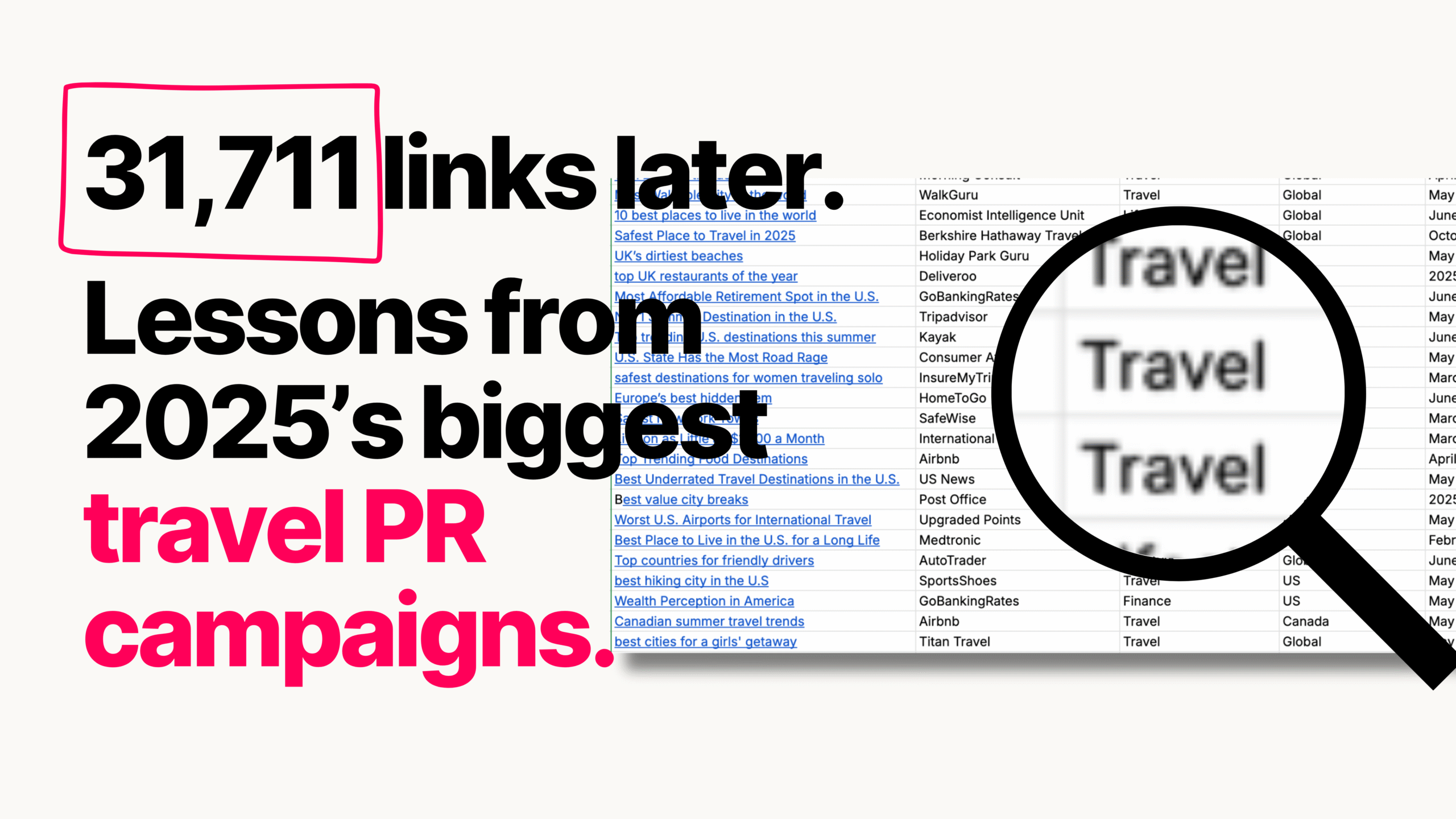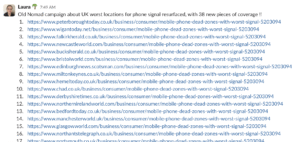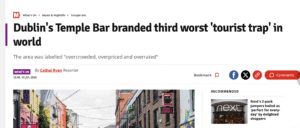31,711 links later. Lessons from 2025’s biggest travel PR campaigns

We analysed the best-performing travel PR campaigns so far this year. Collectively, they secured over 30,000 links. We wanted to see what separated the strongest campaigns from the rest, and what travel brands can actually take forward into the next quarter.
Here goes!
Location-based superlatives
In the UK, we’ve seen that going more granular than regions or counties can make or break coverage. For example, our “Worst Mobile Phone Signal” campaign went down to town level. It landed over 150 links at launch last year and has since picked up another 30+ links organically, without new outreach. Hyper-local results gave journalists a specific, relatable angle to work with—not just “North West England has bad signal,” but “This town ranks as the worst for mobile reception.” That’s an easy headline and one that feels meaningful to local readers.

This approach also plays into how journalists search for stories. Many don’t want national stats, they want a reason why its relevant for their patch. When a campaign has pre-sliced data (city-by-city or town-level), we’re not only pitching a single story we’re handing journalists dozens of potential headlines. That means one campaign can see multiple waves of coverage.
If national titles run it once, you’ve still got smaller local outlets picking it up months later because the story feels new to their area. That’s exactly what kept our mobile signal campaign alive well past its launch window.
Data-led lists and rankings
Every top campaign we analysed used either proprietary or third-party data to build lists or rankings. It’s not new, but it works. Data gives journalists something solid to work with something they can’t just pull together themselves, and that makes your story more credible.
Many of the best campaigns also have staying power because they’re built as resources. If the data’s strong enough, you should position it as something journalists and readers can come back to, rather than a one-off headline grab. For example, a “Global Travel Safety Report” can be updated yearly or refreshed seasonally, making it a go to source instead of something that disappears after a week.
Thinking this way gives campaigns a longer shelf life and a better return on the time and money spent creating them. When done well, you’ll see coverage spike at launch but also trickle in months later without additional outreach, just like we’ve seen with other evergreen campaigns.

Stories tied to the season
Stories tied to a specific season, think summer beaches, winter escapes etc, did better than evergreen ideas. Classic Digital PR advice here, giving you a complete contradiction to the point we just made on building evergreen campaigns, but it’s true. Relevance wins. If making a campaign seasonal is what makes it resonate, then do it. Two things can be true at once 😉.
The good news is, seasons come around every year. If you’ve built a solid data-led campaign, you can repackage and relaunch it with a seasonal spin without having to start from scratch. That way you’re still making the most of your original asset while tapping into timely angles.
Visual campaigns went further
Campaigns with infographics, downloadable maps, or interactive tools tended to perform better. Visuals make life easier for journalists, they can drop them straight into an article and readers engage and share them more readily.
BUT!! Visuals won’t make a bad campaign work. They take more time and money, so only invest when there’s a real reason for them. If the data’s thin or not that interesting, dressing it up won’t save it. Strong campaigns build visuals as part of a resource, not as decoration.
The best-performing visuals we saw were functional. Interactive tools that let readers explore city rankings, maps that local outlets could crop for their region, charts that explained complex data in seconds.
What didn’t work
- Stunt/humour A few campaigns leaned on quirky, one-off ideas without solid data or a clear location hook. They barely got picked up. Journalists don’t have much space for throwaway stories, they need something credible that earns them clicks and shares. A quick stunt might get a laugh and a few links, but it rarely delivers lasting coverage or links. So it really depends on your campaign goals.
- Global angles without localisation Broad, sweeping rankings that cover entire continents or the whole world struggled. From a journalist’s perspective, it’s hard to justify running a story that doesn’t feel relevant to their specific audience. Campaigns that skipped city or regional breakdowns forced journalists to do their own localisation, which most won’t do. That’s why granular campaigns consistently perform better.
- Microsites Some brands launched separate subdomains hoping for bigger impact, but results weren’t better than standard landing pages. Microsites often isolate the campaign from the main brand site, meaning you lose SEO benefit and split link equity. Journalists also don’t care whether your content sits on a subdomain or not, they just want the story. Unless a campaign is massive and recurring, microsites add complexity without payoff.
- Thin data A few campaigns tried to force headlines out of weak or uninteresting numbers. From both a PR and editorial lens, that’s a tough sell. Weak data limits your ability to build compelling angles or visuals, and journalists can spot it a mile off. Those campaigns struggled to gain momentum beyond initial outreach.
- Overly branded content Campaigns that felt like adverts instead of resources didn’t get very far. For the most part, journalists don’t want to run brand messaging. The most successful campaigns hid the “sell” and focused on delivering value first. Again, if you do this or not really depends on your goals. A few bits of coverage for a highly branded campaign is well worth it in some cases.
Takeaways for the rest of the year
- Lead with a location-based superlative Clear, localised hooks still give you the best chance of pickup. But don’t force it. If a campaign doesn’t have a natural city or town angle, you’re better off finding a different hook than trying to shoehorn one in.
- Build with strong data Rankings built on robust proprietary or third-party data work because they give journalists credibility and a ready-made story. But if the data isn’t meaningful or newsworthy, even the best rankings will struggle. Sometimes fewer, stronger data points beat huge datasets.
- Use seasons to your advantage Timely angles tied to a travel season or annual event almost always help. That said, not every campaign needs a seasonal hook. If your story has universal relevance, you can keep it evergreen and just layer in seasonal elements later.
- Include visual assets where it adds value Infographics, maps, and tools lift campaigns because they make journalists’ jobs easier. But they’re not essential every time. Use visuals when they actually help explain or showcase the story, not just to tick a box.
- Avoid stunts without substance Creative ideas work best when they’re built on solid data or a clear location tie-in. Novelty for novelty’s sake usually falls flat, unfortunately.
The most successful campaigns we analysed all kept things simple: a strong location hook, data journalists could trust, and assets that made stories easy to run. These aren’t hard rules, sometimes a campaign breaks the pattern and still does well, but they’re a solid reference point for planning digital PR that actually lands.
Methodology: We analysed 35 of the highest-performing travel PR campaigns from Q2 2025. Together, they earned 31,711 links. We looked at their headlines, use of data, visuals, and campaign structure to see what consistently worked and what didn’t.
Want more of this?
Sign up to our newsletter 👇
Unsubscribe anytime.